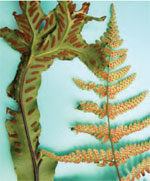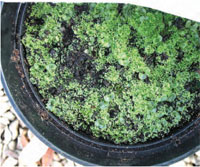Principles of Horticulture / Plant reproduction
Reproduction in simple multicellular green plants
Content
 |
Figure 7.10 Fern spores
on underside of leaves,
Dryopteris erythrosora
and Phyllitis
scolopendrium Cristata |
The seed-producing plants represent the most important
division of the plant kingdom in horticulture. Other,
simpler multicellular green plants reproduce sexually, but
also asexually. Alternation of generations exists when
two stages of quite distinct types of growth occur. In
ferns (Pteridophyta), a vegetative stage produces a spore
forming body on the underside of leaves (see Figure 7.10).
Spores are released and, with suitable damp conditions,
 |
Figure 7.11 Germinating fern
spores and plantlets |
germinate to produce a sexual leafy stage in which male
and female organs develop and release cells which fertilize
and develop in the body of the plant. These spores then
germinate while nourished by the sexual leafy stage and
develop in turn into a new vegetative plant. Ferns can be
produced in cultivation by spores if provided with damp
sterile conditions to allow the tiny spores to germinate
without competition (see Figure 7.11). Vegetative
propagation by division of plants or rhizomes is common.
Many plants are able to reproduce both sexually and
asexually by vegetative propagation. This is described in
detail in Plant Propogation.
|
Support our developers
